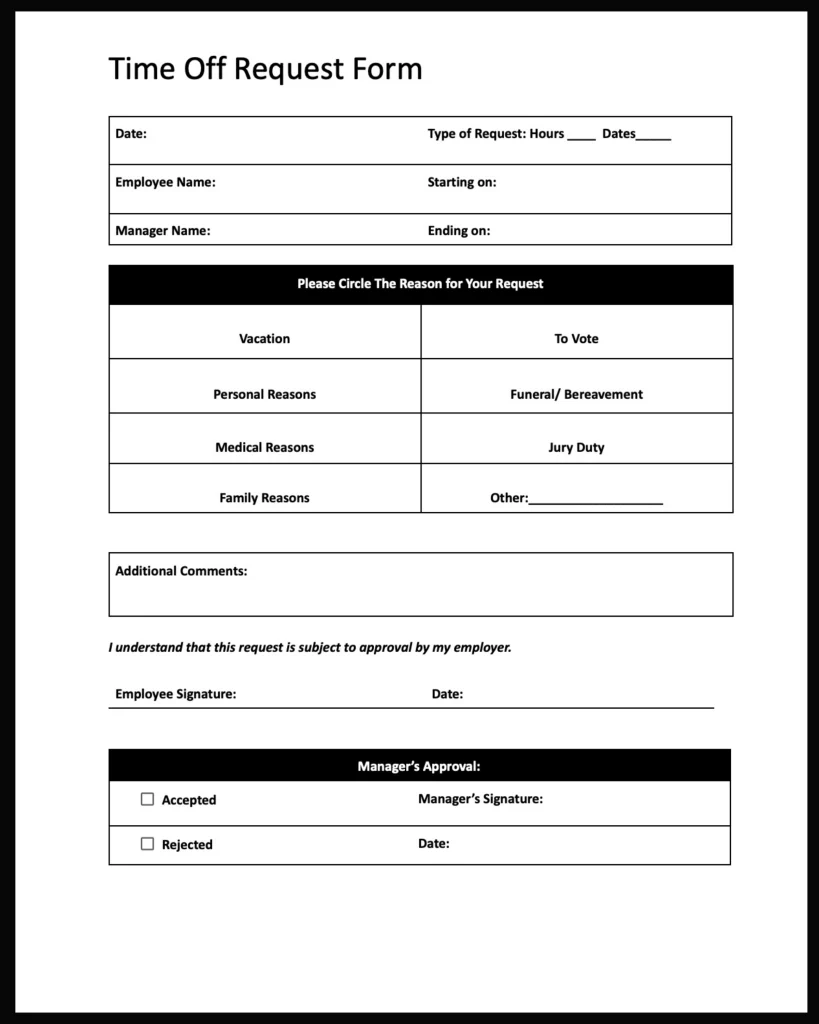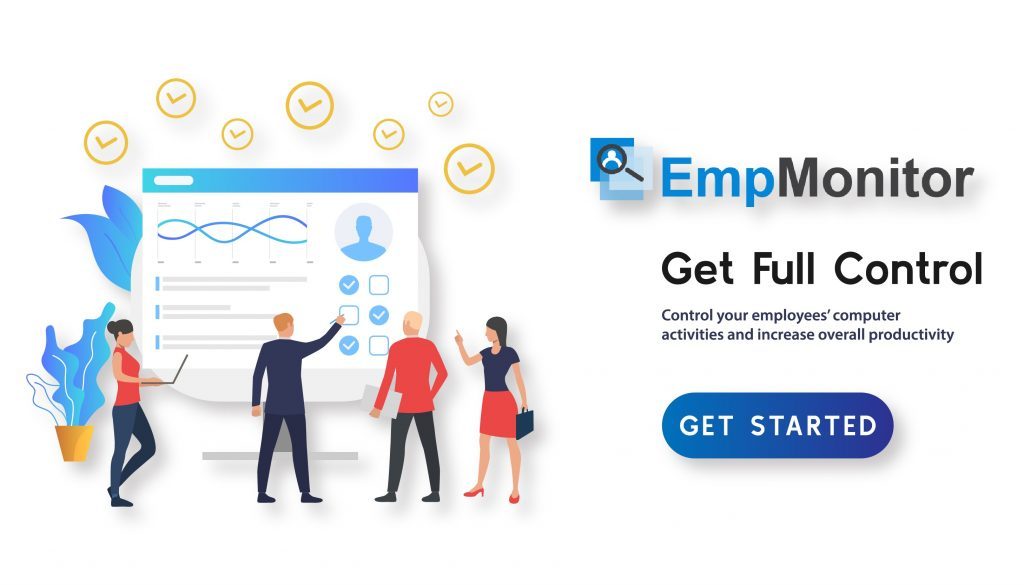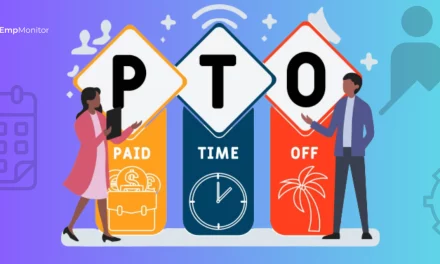Time management is a binding part of any organization’s operations, and one of the most important parts of that process is handling employee time off requests.
Balancing the needs of employees seeking a breather while ensuring smooth payroll operations is a delicate dance that often tests the patience and efficiency of even the most seasoned HR professionals.
A more efficient process not only provides employees with the rest they require but also avoids downtime. In this blog, we will delve into the intricacies of handling time-off requests and share seven best practices to make the process smoother.
As a bonus, we’ll furnish you with a ready-to-use template that promises to alleviate the stress of processing these requests, ensuring your business runs smoothly, your team stays content, and payday headaches become a thing of the past.
So, what are you waiting for?
Let’s jump right into it!!
Listen To This Blog Now!!
What are Time Off Requests?
Time off requests are formal submissions made by an employee to their employer, seeking approval for planned absences from work. It is a fundamental process in workforce management, allowing employees to communicate their need for time away from the workplace for various reasons. These reasons may include Vacation, Personal days, Medical leave, Family emergency, or Other personal commitments.
The time off request serves as a documented communication between the employee and the employer, outlining the specific dates the employee wishes to be absent and the reason for the request. This allows employers to plan for workforce shortages, streamline workloads, and maintain business continuity.
Typically, employees are required to follow a designated procedure when submitting a time off request, adhering to the company’s policies and guidelines. The employer, often through the human resources department or a designated manager, reviews the request and decides whether to approve or deny it based on factors such as business needs, staffing levels, and fairness among the workforce.
Formalizing the claim process allows you to establish a time off management workflow, improve transparency, and establish a consistent approach to claims management across your organization. Both employees and employers benefit from this structure, as it helps to create a positive work atmosphere and avoids disruption caused by unexpected absences.
What Is The Benefit Of Managing Time Off Requests Properly?
Appropriately managing employee time off requests offers numerous benefits to both employees and employers, contributing to a more harmonious and productive work environment.
Here are some key advantages:
Enhanced Employee Satisfaction:
Efficiently handling time-off requests shows employees that their personal needs and work-life balance are valued. This, in turn, leads to higher job satisfaction and increased morale. Satisfied employees are more likely to be engaged in their work and contribute positively to the workplace.
Reduced Absenteeism and Disruptions:
Proper management of leave requests allows organizations to plan for potential staffing gaps and mitigate disruptions caused by unexpected absences. A well-defined set of policies and procedures helps to identify and resolve issues, reduce absences, and streamline workflows.
Improved Productivity and Workforce Planning:
An organized time-off system contributes to improved productivity by ensuring that workloads are managed effectively during absences. Analyzing time-off data helps in strategic workforce planning, allowing organizations to optimize staffing levels and maintain productivity even during peak vacation times.
Positive Employee Relations and Organizational Culture:
Transparent and fair time off requests management fosters positive employee relations. Employees appreciate clear communication, consistent policies, and fair treatment, which contribute to a positive organizational culture. A healthy workplace culture, in turn, enhances collaboration and teamwork.
Attraction and Retention of Talent:
Companies that have time-off policies in place and manage them efficiently are more appealing to potential employees. These types of companies illustrate their focus on the needs of their employees and their commitment to a balanced work-life life.
Additionally, satisfied employees are more likely to stay with the company, reducing turnover and supporting talent retention efforts.
7 Time Off Request Best Practices For Better Pay Management
Define The Rules Of Time Off Requests:
Establish and communicate the rules and procedures for submitting time-off requests. Outline factors such as the notice period required, any blackout dates during peak business times, and the preferred method of submission. Providing clarity upfront helps set expectations and ensures a consistent process for all employees. Employees should have a clear understanding of what is expected, fostering a sense of fairness and transparency in the request process.
Establish A Policy For Overlapping Requests:
In situations where multiple employees request time off for the same period, having a fair policy in place is essential. Consider factors like seniority, past approvals, or implementing a rotating schedule to determine the order of approval. This policy ensures transparency and minimizes potential conflicts among employees. By addressing overlapping requests systematically, you create a fair and equitable approach that maintains team harmony.
Make A Form That Everyone Should Use:
Create a standardized time off requests form that includes all necessary details. This form should capture information such as the requested dates, the reason for the request, and any supporting documentation required.
A uniform form simplifies the review process for managers and ensures consistency in the information provided by employees. Not only does this save time, but it also minimizes the risk of mistakes or missing data.
To save your time here is a custom make request days off template to us and share with your employee.
Build a rotating time off schedule:
Implementing a rotating time off schedule distributes time off opportunities more equitably among employees. This approach prevents any single department or team from consistently being short-staffed, promoting a fair and balanced work environment.
It also helps in long-term workforce planning. A rotating schedule ensures that employees across all levels get fair access to preferred time off periods, contributing to a positive workplace culture.
Read More:
Time Off Request- Meaning, What To Include In Policy, & More!
7 Workforce Management Mistakes To Avoid In Your Organization
Top Reasons You Should Use Geofence Time Clock
Make It Easy For Employees To Submit Their Requests:
Simplify the time off requests submission process to encourage timely requests. Provide multiple channels for submission, such as an online portal, email, or a physical form.
Accessibility enhances the employee experience and contributes to an organized and efficient time off management system. Not only does a streamlined submission process promote timely applications, but it also demonstrates an organization’s dedication to employee convenience and well-being.
Keep All Your Time Off Requests In One Place:
Invest in workforce management software to consolidate all time-off appeals into a centralized system. Using this software you can avoid workforce management mistakes for easy tracking, reviewing, and managing employee time off requests.
It also enables HR departments to generate reports on time off patterns, aiding in strategic planning for staffing needs. Centralizing requests in one place enhances efficiency, reduces the risk of oversight, and provides valuable insights for optimizing workforce management.
Enter EmpMonitor, a comprehensive workforce management software designed to simplify time off management and enhance overall operational efficiency. This innovative tool provides a seamless solution to keep all your time off requests in one place, addressing the challenges associated with manual tracking and approval processes.
EmpMonitor| Employee Time Tracking Software
EmpMonitor is a powerful workforce management software that enables employers to monitor and manage employees’ productivity without the need for physical examination.
The software is used by small to large-sized companies, enterprises, and government organizations and is suitable for business owners, IT managers, and project managers seeking workforce optimization.
EmpMonitor offers several benefits for businesses, including:
Increased productivity: Its ability to track employee activity can help employers spot time lags or areas where employees aren’t performing as well as they could be, enabling them to make changes to increase productivity.
Improved time management: With this time tracking software capabilities, employers can determine the amount of time employees spend on a particular task, enabling more efficient time management and better project planning.
Enhanced security: EmpMonitor’s keystroke tracking and website/application usage monitoring can help identify potential security risks and prevent data breaches.
Real-time monitoring: It provides real-time monitoring of your employees so you can troubleshoot issues as they arise.
Comprehensive reporting: EmpMonitor offers detailed reports on employee activity, including productivity, attendance, and time tracking, providing valuable insights for employers to make informed decisions.
Overall, EmpMonitor can help businesses optimize their workforce, improve productivity, and enhance security, making it a valuable tool for businesses of all sizes.
Plan For Emergencies:
Despite meticulous planning, unexpected emergencies can arise. Develop contingency plans to address unforeseen absences. This could involve cross-training employees for essential tasks, maintaining an on-call list, or exploring temporary staffing solutions.
A well-thought-out plan helps reduce the impact of unplanned time-off requests. A well-thought-out emergency plan ensures that the organization can adapt swiftly to unforeseen challenges, maintaining business continuity and reducing the stress associated with unexpected absences.
Conclusion
Effectively managing leave requests is vital for maintaining a healthy work environment. It’s about cultivating a workplace environment that values both employee well-being and organizational productivity. Time off pleads are also one of the reasons to use the geofence time clock feature of the management tool to keep the best record of attendance.
Using a standardized time off request form and establishing clear policies can significantly contribute to a more organized and productive workplace. With EmpMonitor as your ally, you’re not just managing employee time off requests; you’re elevating your organization’s capacity to harmonize the personal and professional aspects of your employees’ lives.
It’s important to remember that a well-functioning time off request system isn’t just about providing leave. It’s about creating a work environment that promotes employee health and well-being.















